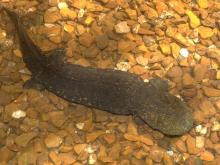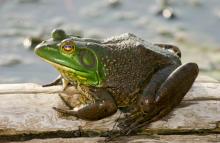Reptiles and Amphibians
Media

Species Types
Scientific Name
Necturus maculosus maculosus
Description
Mudpuppies are aquatic salamanders that have plumelike external gills throughout their entire lives. They’re found in the southern half and along the eastern edge of Missouri.
Media

Species Types
Scientific Name
Cryptobranchus alleganiensis alleganiensis
Description
The eastern hellbender is a large, entirely aquatic salamander with a wide, flat head, small, lidless eyes, and soft folds of skin on the sides. In Missouri, it occurs in the northern Ozark highlands in spring-fed rivers that drain north into the Missouri and Meramec river drainages.
Media

Species Types
Scientific Name
Apalone spinifera spinifera
Description
The eastern spiny softshell is a medium to large softshell turtle with small bumps or spines on the front edge of the upper shell. There are dark spots on the fore- and hind limbs.
Media

Species Types
Scientific Name
Graptemys geographica
Description
The northern map turtle is a medium-sized aquatic species with a low ridge along the center of the upper shell. A small yellow spot is present behind each eye. It occurs mainly in the Ozarks and the upper Mississippi River in northeastern Missouri.
Media
Species Types
Scientific Name
Graptemys ouachitensis
Description
The Ouachita map turtle is a medium-sized aquatic species with a prominent ridge down the center of the upper shell and bright yellow lines on the head and limbs. A large yellow marking behind each eye extends, narrowing, on top of the head. It occurs in southern and eastern Missouri.
Media

Species Types
Scientific Name
Chrysemys picta bellii
Description
The western painted turtle is a small, brightly colored aquatic turtle. The upper shell is smooth and has a red-orange outer edge. The colorful lower shell has a prominent pattern of brown markings. It is found nearly everywhere in the state except the southeast region.
Media

Species Types
Scientific Name
Kinosternon subrubrum hippocrepis
Description
Although well equipped for an aquatic existence, the Mississippi mud turtle spends as much time wandering about on land as it does in water. Look for it in the Mississippi Lowlands of Missouri’s Bootheel.
Media

Species Types
Scientific Name
Lithobates catesbeianus (formerly Rana catesbeiana)
Description
The American bullfrog is Missouri’s largest frog. This common species is easy to hear on warm nights when the males call a deep, sonorous “jug-a-rum, jug-a-rum” that can be heard from half a mile away.
Media

Species Types
Scientific Name
Kinosternon flavescens
Description
The yellow mud turtle is a small, uniformly colored, semiaquatic turtle restricted to certain counties in west-central, northeastern, and southwestern Missouri. It is an endangered species in our state.
Media

Species Types
Scientific Name
Chrysemys dorsalis
Description
The southern painted turtle is small and has a prominent yellow, orange, or red lengthwise stripe down the middle of the upper shell. In Missouri, this aquatic turtle is found only in the Bootheel region.
See Also
About Reptiles and Amphibians in Missouri
Missouri’s herptiles comprise 43 amphibians and 75 reptiles. Amphibians, including salamanders, toads, and frogs, are vertebrate animals that spend at least part of their life cycle in water. They usually have moist skin, lack scales or claws, and are ectothermal (cold-blooded), so they do not produce their own body heat the way birds and mammals do. Reptiles, including turtles, lizards, and snakes, are also vertebrates, and most are ectothermal, but unlike amphibians, reptiles have dry skin with scales, the ones with legs have claws, and they do not have to live part of their lives in water.





















